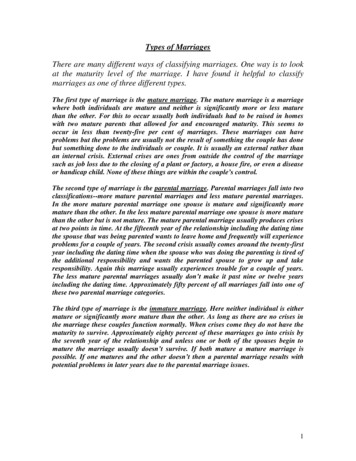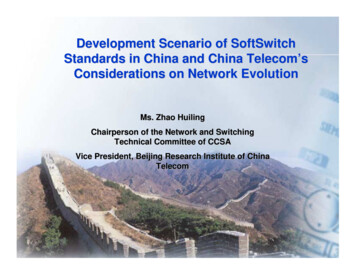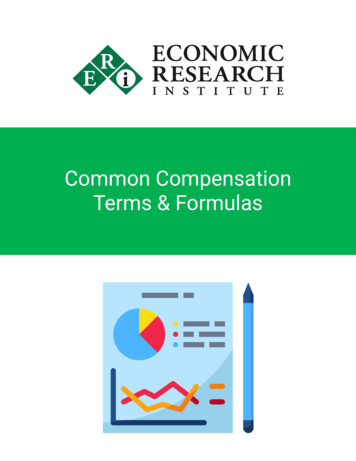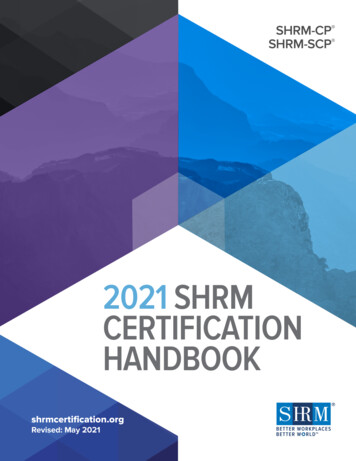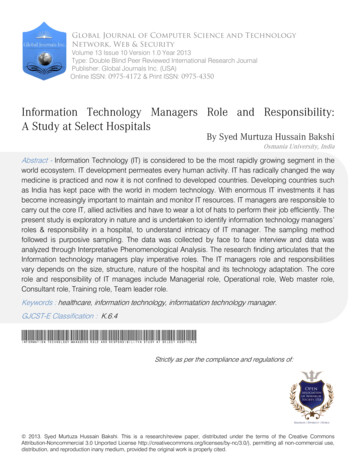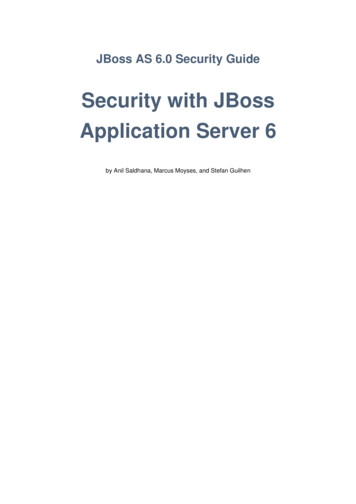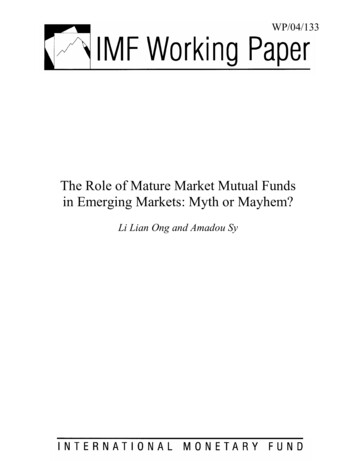
Transcription
WP/04/133The Role of Mature Market Mutual Fundsin Emerging Markets: Myth or Mayhem?Li Lian Ong and Amadou Sy
2004 International Monetary FundWP/04/133IMF Working PaperInternational Capital Markets DepartmentThe Role of Mature Market Mutual Funds in Emerging Markets: Myth or Mayhem?1Prepared by Li Lian Ong and Amadou SyAuthorized for distribution by Donald J. MathiesonJuly 2004AbstractThis Working Paper should not be reported as representing the views of the IMF.The views expressed in this Working Paper are those of the author(s) and do not necessarily representthose of the IMF or IMF policy. Working Papers describe research in progress by the author(s) and arepublished to elicit comments and to further debate.The expansion of the global mutual funds industry has been characterized by growth inmature as well as emerging markets. This has clearly contributed to the development of localsecurities markets in emerging market economies, which in turn, has been key in attractinginvestment inflows from overseas funds. A major concern, however, is that large foreigninvestors could significantly disrupt the stability of local capital markets in the event of amarket shock, with systemic implications for the real economy. Our estimates suggest thatwhile local investors remain the more important group in terms of market share, the influenceof foreign funds cannot be discounted. Asset allocation decisions by mature market funds—both dedicated and crossover—in aggregate, could affect emerging markets. In particular,European mutual funds appear to play a much bigger role in emerging markets than theirU.S. counterparts.JEL Classification Numbers: F21, G15Keywords: asset allocation, crossover investors, dedicated investors, emerging markets,mature markets, mutual fundsAuthors’ E-Mail Addresses: long@imf.org, asy@imf.org1The authors wish to thank Francesc Balcells, Don Mathieson, Markus Krygier and GabrielSensenbrenner for their useful comments, and Silvia Iorgova and Peter Tran for researchassistance. All mistakes remain the responsibility of the authors.
-2ContentsPageI.Introduction.3II.Global Industry Overview.4III. Trends in Asset Allocation.5IV. Dedicated and Crossover funds in Mature Markets.8V.Extensions: Portfolio Optimization.14VI. Conclusion .15Figures1. Mutual Funds: Total Net Assets by Market.42. Global Mutual Funds: Total Net Assets by Fund Type .53. U.S. Household Ownership of Mutual Funds.54. U.S. Equity Mutual Funds: Net New Cash Flows .65A. Singapore: Source of Discretionary Funds by Region, 2002.75B. Singapore: Investment of Discretionary AUM by Region, 2002 .76. Mexico: Net Asset Values by Fund Type .87. Emerging Markets Investor Class.98. U.S. Mutual Funds: Retail Net Flows. 109. The Efficient Frontier, January 1991 to July 2002 . 14Tables1A. Mutual Funds: Total Net Assets . 171B. Mutual Funds: Growth in Total Net Assets . 182A. Mutual Funds: Total Net Assets by Fund Type . 192B. Mutual Funds: Net Assets by Fund Type as Proportion of Total Net Assets . 203. U.S. World Mutual Funds: Estimated Allocation to Emerging Markets. 214. Mutual Funds: Asset Allocation in Selected Markets, 2003. 225. European World Mutual Funds: Estimated Allocation to Emerging Markets. 23References. 24
-3I. INTRODUCTIONThe increase in global assets under management (AUM) in recent years has beencharacterized by growth in institutional investors’ assets, in both mature and emergingmarkets. The retail sector has also played an increasingly important role in channeling fundsto asset managers for investment. The expansion of the mutual fund industry is largelyattributable to the proliferation of investment opportunities globally, as countries havecontinued to liberalize their capital markets, reduce trade barriers and demutualize. Thegrowing middle class in many mature and emerging market economies is also expected tosupport the expansion of mutual fund sales in the future. From an institutional perspective,the privatization of pension systems and increasing market penetration of the insuranceindustry—especially in emerging markets—is also expected to increase the demand formutual fund products.2A mutual fund can be defined as an investment company that combines the assets ofinvestors—individual and institutional—and collectively invests those assets in stocks, bondsand/or money market instruments. Investors invest in a mutual fund by purchasing sharesissued by the fund, which then uses the cash raised to invest in portfolios of stocks, bondsand other securities. Mutual funds also tend to continuously offer new fund shares to thepublic. Mutual funds are “open-end” investment companies in that they are required toredeem outstanding shares at any time, upon demand, and at a price determined by thecurrent value of the funds’ net assets, known as the net asset value (NAV). There aregenerally four types of mutual funds: equity, bond, hybrid and money market.3In emerging markets, the exponential growth in the local mutual fund industry has clearlycontributed to the development of local securities and derivatives markets, which in turn, hasbeen key in attracting investment inflows from overseas funds. More importantly, the greaterdepth and liquidity of local markets has reduced reliance on external funding. Mutual fundsin emerging markets tend to invest locally, as they are, in many cases, “captive” due toinvestment restrictions or are simply averse to investing offshore. Thus, policymakers havetended to focus on the role of mature market mutual funds—which clearly dwarf the localones in size—in these emerging markets. The biggest concern is that asset reallocationdecisions by these foreign investment funds could significantly disrupt the stability of local2See Chapter IV of the Global Financial Stability Report, March 2004, for further discussionon the global pension and insurance industries.3In contrast, a “closed-end” fund issues a fixed number of shares which trade on the stockexchange or the over-the-counter market. A unit investment trust (UIT) buys and holds afixed portfolio of stocks, bonds or other securities; units in the trust are sold to investors whoreceive their proportionate share of dividends or interest paid by the respective investments.A UIT has a stated date for termination, upon which investors receive their proportionateshare of net assets. An exchange-traded fund (ETF) is an investment company whose sharesare traded on stock exchanges at market-determined prices.
-4capital markets, in the event of a market shock, with systemic implications for the realeconomy.4In this paper, we estimate the importance of mature market mutual funds in emerging equityand bond markets, vis-à-vis local mutual funds, and assess their potential impact on marketstability. In this context, we also consider the importance of the investor base, namely,crossover versus dedicated investors. Finally, we provide an assessment on the issue ofportfolio optimization by mature market mutual funds in their emerging market assetallocations. Our findings suggest that asset allocations by mature market funds into emergingmarkets, while not inconsequential, are still much less important than the holdings ofdomestic investors. Mutual funds in mature European markets appear to play a bigger role inemerging markets than their U.S. counterparts, with greater potential to influence localmarkets. Meanwhile, the portfolios of European funds appear to be more optimal than thoseof their U.S. counterparts, although both still exhibit home bias in their allocations.The paper is presented as follows: Section II provides a broad overview of the developmentsin the industry, followed by a discussion on asset allocation trends in Section III. In SectionIV, we estimate the allocations by dedicated and crossover mutual funds from maturemarkets into emerging markets, and discuss the stability implications of these and other localmarket investors. Section V provides a brief discussion on the diversification benefitsachieved by U.S. and European investors, followed by the conclusion in Section VI.II. GLOBAL INDUSTRY OVERVIEWThe net assets of the global mutual fundindustry has grown more than six-foldFigure 1Mutual Funds: Total Net Assets by Marketsince 1990, to 14 trillion at the end of(In billions of US dollars, end of period)Emerging markets2003 (Tables 1A and 1B). Notably, theMature marketsmutual fund industry in emergingmarkets has grown sharply over thisperiod, by more than 19 times its size in1990, notwithstanding the financialcrises that has beset some of thesemarkets since the mid-1990s. Despitethe surge in total net assets, however,mutual funds in emerging markets stillSources: Investment Company Institute, Securities Commission of Malaysia, Securities and Exchange Commission ofonly represent less than 5.7 percent ofThailand.total global net assets (Figure 1), withemerging Asia accounting for 3.7 percent of the global 20022003Broner, Gelos and Reinhart (2003) argue that the allocation decisions of international funds,in response to their performance, could result in financial market spillovers into othermarkets, notwithstanding differences in country fundamentals.
-5In aggregate, equity mutual funds are clearly the most popular within the industry, with43 percent of total global net assets as at the end of 2003, or 5.9 trillion (Figure 2). Moneymarket funds are next in size, with 24 percent of the total net assets. Indeed, the trend overtime shows continuous growth in global money market fund aggregates, in contrast withequity funds, which have tended to be more “volatile.” Similarly, bond funds have continuedto post positive growth in net assets since 2000.Figure 2Significantly, U.S. mutual funds aloneGlobal Mutual Funds: Total Net Assets by Fund Type(In billions of US dollars, end of period)make up 53 percent of the industry’sEquitytotal global net assets, which is someMoney MarketBond1.6 times the size of the industry in allHybridthe mature European marketsOthercombined, and 8.5 times that of itsmature market counterparts in theAsia-Pacific region. U.S. investors hadplaced some 7.4 trillion in 8,126mutual funds as at end-2003,compared to 6.4 trillion invested inSource: Investment Company Institute8,244 funds at the end of 2002. Theanticipation of a strong economicrecovery and improving corporate profitability saw equity fund assets rise 37 percent to 3.7 trillion in 2003, from 2.7 trillion in 2002.7,0006,0005,0004,0003,0002,0001,00001998The increasing popularity of mutualfunds in United States is clearlysupported by the investment profile ofdomestic households since the 1980s(Figure 3). Almost half of allhouseholds were owners of mutualfunds by the end of 2003. Theseinvestors made 668 billion of netpurchases of financial assets in 2002,up 21 percent from 554 billion theprevious year. They were net buyers ofmutual funds ( 164 billion), bonds andbank deposits, albeit net sellers ofdirectly held stocks.19992000200120022003Figure 3U.S. Household Ownership of Mutual Funds6060Millions of households50504040Percent of all 98200020022003Source: Investment Company InstituteIII. TRENDS IN ASSET ALLOCATIONAllocations to different asset classes tend to differ across countries and regions (Tables 2Aand 2B), depending on market infrastructure, availability of instruments to invest and hedge,liquidity of market, as well as risk considerations. For instance, mutual funds in United Stateshold the largest proportion (44 percent) of their net assets in equities, while funds in LatinAmerica are predominantly invested in fixed income instruments (68 percent). Allocations byEuropean mutual funds appear to be evenly balanced between equity and bond funds.
-6-In terms of global allocations, while international mutual funds do have some presence inemerging market local currency bonds and equities,5 few markets generally meet theirinvestment criteria, which may include ease of exit, an attractive tax structure, along withclearing and settlement considerations. The issue of investability, where foreigners areprohibited from purchasing, or restricted to a limited fraction of, a given company’s stock,has also excluded foreign investors from any significant holdings in emerging markets. Thatsaid, as the emerging market asset class becomes more mainstream, mutual fund managersare pushing more local market instruments and promoting hybrid mandates,6 that areincidentally becoming popular amongst European investors seeking to diversify theirholdings.In United States, surveys of fundFigure 4U.S. Equity Mutual Funds: Net New Cash Flowsmanagers indicate that they too are(In billions of US dollars)300planning to increase their holdings ofemerging markets instruments—both250Domesticequities and bonds—in their portfolios. 200This is in contrast to investor150preference over the past decade, with100domestic equity funds increasinglydominating those of foreign equity50funds up to 2000 (Figure 4).7 Net new0cash inflows into all U.S. equity funds1990 1991 1992 1993 1994 1995 1996 1997 1998 1999 2000-50peaked at 310 billion in 2000, ofSource: Investment Company Institutewhich 260 billion were allocated todomestic funds and the remainder to foreign assets.Foreign200120022003Interest in emerging market equity funds has been growing in Asia, in line with the globaleconomic recovery and the perceived ‘undervaluation’ of Asian assets. Hong Kong SAR andSingapore are unique within the emerging markets in that they represent regional assetmanagement hubs, with funds largely sourced from and invested overseas. In Singapore,there has been substantial growth in the asset management industry since 1997, with AUMgrowing by 65 percent to about 200 billion at the end of 2002.8 Some 70 percent of funds5A few examples include South Africa, Mexico and some East European markets.6A typical hybrid mandate consists of a mixed portfolio of fixed income securities of majorindustrial countries and emerging market countries.7Home bias in portfolios is well-documented in surveys by Lewis (1999) and Karolyi andStulz (2002). However, Edison and Warnock (2003) find no home bias by U.S. investorstowards emerging market equities that are cross-listed on U.S. exchanges. They attribute thisto the reduction in information asymmetries associated with the cross-listings.8This total includes discretionary and non-discretionary assets (which include funds underadvisory service and funds contracted by financial institutions in Singapore. The Singapore(continued )
-7are sourced externally—from United States, Europe and the Asia-Pacific region, whileinvestments into overseas markets account for 82 percent of funds (Figures 5A and 5B). InHong Kong SAR, 63 percent of AUM of around 200 billion are sourced from overseas, withthe balance sourced from local investors. Of this amount, 76 percent are invested abroad; theremaining 24 percent, which is invested locally, represents almost 48 billion of assets undermanagement or around 30 percent of GDP.9 In contrast to these two markets, the opposite istrue of Korea, another important market for mutual funds, where net assets totaling some 134 billion (or 26 percent of GDP) are largely held in local securities. About 87 percent ofAUM by investment trust management companies (ITMCs) is allocated to local fixedincome instruments, with the rest placed in equities.10Figure 5ASingapore: Sources of Discretionary Funds by Region, 2002Others, 18%Others, 9%Singapore, 30%Asia-Pacific (exSingapore), 13%North America, 14%Source: Monetary Authority of SingaporeFigure 5BSingapore: Investment of Discretionary AUM by Region, 200Asia-Pacific (exSingapore), 51%Europe, 25%Singapore, 18%North America, 10%Europe, 12%Source: Monetary Authority of SingaporeWithin Eastern Europe, the mutual fund industry has grown rapidly in both Hungary andPoland, with net assets of about 5 and 4 percent of GDP, respectively. The industry isauthorities have actively encouraged the growth of the industry by allocating “developmentalfunds” of more than S 35 billion ( 20 billion)—comprising S 10 billion ( 5.8 billion) fromthe Monetary Authority of Singapore (MAS), S 25 billion ( 14.6 billion) from theGovernment Investment Corporation (GIC) plus an allocation from Temasek Holdings—toforeign fund managers. The authorities are also offering concessionary tax rates for approvedfund managers (of 10 percent versus the usual 20 percent). Investors in also benefit from taxconcessions.9While the funds invested Hong Kong SAR are predominantly in equities, at approximately56 percent, the proportion of funds invested in bonds has grown substantially to around24 percent, which is attributed to the government’s efforts to develop the local bond market.10Some 70 percent of inflows into the ITMC industry are from institutional investors, whilethe rest is sourced from the retail sector. That said, local mutual funds only hold 4.5 percentof Korea’s stock market capitalization and 5 percent of total outstanding debt, while foreigninvestors currently own about 40 percent of Korea’s stock market capitalization—the highestforeign ownership in the region—compared to around 14 percent prior to the Asian crisis in1997.
-8extremely competitive in Hungary, partly owing to the lack of up-front fees, while the growthof the industry in Poland was prompted by the approval of the “Belka tax,” a tax on bankdeposits that caused a sharp shift of retail funds away from the banking system. These fundswere initially allocated to fixed income mutual funds, and more recently to equity and hybridfunds.Latin America’s mutual funds industryFigure 6Mexico: Net Asset Values by Fund Typeis the second largest in emerging(In percent of GDP)markets after Asia, with net assets of7Equity funds 221 billion. Of this amount, Brazil’s6Fixed income funds -- institutionsmutual funds represent 172 billion (or 5Fixed income funds -- individuals78 percent) of total net assets, with 594percent of this amount allocated to3bond funds (Table 2B). The mutual2fund industry in Mexico has grownrelatively quickly, despite lasting scars 10from the peso crisis in the 20022003*During 2000–03, the total net assets of Sources: FundPro and WEO* NAV as at end-June 2003Mexico’s mutual funds grew rapidlyand have predominantly been invested in fixed income instruments (Figure 6).11 Similarly,mutual funds in Colombia have concentrated exclusively on fixed-income instruments,concentrated in medium- and long-term government bonds.12IV. DEDICATED AND CROSSOVER FUNDS IN MATURE MARKETSAn important development in changes to the emerging market investor base has been theascendancy of “crossover” relative to “dedicated” investors (Figure 7).13 The difficultyarises, however, in the definition of “dedicated” versus “crossover” investors for emergingmarkets. Broadly defined, a dedicated investor is one whose performance is measured againstan emerging markets asset benchmarks, such as the Emerging Markets Bond Index (EMBI)or the Morgan Stanley Capital International (MSCI) indices. Crossover investors are themain institutional investors in instruments such as investment-grade debt and mature markethigh-yield securities. They tend to invest in emerging market assets to improve returns, andare thus more opportunistic. Crossover accounts tend to move in and out of a particular assetclass, while dedicated investors usually reallocate within the asset class.11The majority of fixed-income mutual funds are invested largely in peso-denominatedgovernment debt, due to previous restrictions on overseas investments. However, the liftingof restrictions on overseas investments on September 2003 has since seen local mutual fundslaunch international funds.1213Equity mutual fund practically disappeared after the stock market sell-off in 1996–97.Chapter IV of the Global Financial Stability Report, International Monetary Fund,September 2003, provides a discussion on these two classes of investors.
-9-Figure 7Emerging Markets Investor Class (In percent)100908070605040Cross overHedge fundsDedicated EM fundsLocalsDistressed playersCommercial Banks30201001990 1991 1992 1993 1994 1995 1996 1997 1998 1999 2000 2001 2002Source: PIMCOTraditionally, the categories of crossover equity investors include global equity funds (whichinvest primarily in equity securities traded worldwide, including U.S. companies) andinternational equity funds (which invest primarily in equity securities of companies locatedoutside United States). Dedicated equity funds include emerging market funds (which investprimarily in companies based in developing markets around the world). Meanwhile, regionalequity funds (which invest in companies based in a specific part of the world, and maycomprise both mature and emerging markets), could represent either dedicated or crossoveraccounts, albeit more benchmark indices are available for the former.14 Within the fixedincome universe, crossover investors include global bond funds (which invest in debtsecurities worldwide, and may invest up to 25 percent of assets in companies located inUnited States) and international bond funds (which must invest at least two-thirds of theportfolio outside United States). Emerging market bond funds invest primarily in the debt ofless-developed regions.The improving credit quality in emerging markets, as evidenced by the numerous creditupgrades in 2003, has instilled confidence in traditional high-grade crossover investors. Forinstance, recent institutional mandates to invest in emerging debt are widely considered astable source of funds, as they are generally seen as longer-term, strategic allocationdecisions. As more emerging market sovereigns receive an investment grade rating overtime, and an increased proportion of global investment portfolios are committed to thesecountries which are included in core benchmarks, capital flows to these countries areexpected to become less volatile. Already, more than 40 percent of the Emerging MarketsBond Index Global (EMBIG) is represented by investment grade issuers.Overall, institutional inflows are viewed as a more stable source of assets under management,compared to the retail flows which have been fuelling the growth of emerging market bondfunds over the past year. The less sophisticated retail investors are seen to be more likely to14For instance, the widely-used MSCI group of regional equity indices largely compriseseparate benchmarks for either mature or emerging markets.
- 10 pull out their investments quickly during a market event. For instance, most Europeaninstitutional investors are said to prefer to follow buy-and-hold strategies unless their viewson a country turn excessively negative. Additionally, the large size of some portfolios, hightransaction costs and lack of liquidity in emerging markets prevent excessive trading, andpractically ensure that fund managers adopt a buy-and-hold approach, which sometimesmakes tactical asset allocations in emerging markets rather difficult.15The stability of the crossover base for emerging market assets remains uncertain, as it has yetto be tested by a major market shock in recent years, following the emerging market crisis of1997–98. While analysts have noted that the increase in crossover investors has correspondedwith increased market volatility, these investors tend to buy and hold assets despite theirdisplay of opportunistic behavior vis-à-vis emerging market assets. This is evidenced by theirsupport for Brazilian assets after the 2002 crisis.Given the size of the mutual funds industry in mature markets, relative to the emergingcountries, it is not surprising that asset allocations by the former into the latter have been ofsome concern for policymakers. Notably, the potential for these mature market mutual fundsto exacerbate market volatility, in the event of a market shock, may be significant.U.S. crossover funds in both equityand debt asset classes have clearlybenefited from new net flows fromretail investors in 2003 (Figure 8). Onbalance, equity funds have been moreattractive, compared to bond funds,with international equity funds inreceipt of net cash inflows of almost 14 billion for the year, whilededicated emerging markets equityaccounts posted net inflows of almost 5 billion. The size of internationaltype equity mutual funds in UnitedStates was 17 times that of debt mutualfunds in 2002.Figure 8U.S. Mutual Funds: Retail Net Flows(In billions of US dollars)162002200312840Int'l & globaldebtEM debtGlobalequityInt'l equityEM equityEuropeequityLatam equityAsia-Pacequity-4-8Source: AMGIndeed, allocations to mutual funds with the mandate to invest in equities outside of UnitedStates are not insignificant. In 2003, the total net assets of all (long-term) U.S. crossover anddedicated emerging market funds amounted to 518 billion out of the 3.7 trillion in allequity funds, or about 14 percent.15That said, the monthly assessment of performance required in some emerging markets(e.g., in some Latin American markets) may implicitly restrict the investment horizon to onemonth.
- 11 Dedicated investors have 100 percent allocation to emerging market securities, so that thetotal net assets of dedicated investors in emerging markets in a particular country k could becalculated as:(1)nAD , k ,t 1 Di ,k ,t ,i 1where AD,k,t is the total net assets allocated by dedicated equity funds in country k toemerging market equities at time t, and Di,k,t is the net assets in a particular dedicated equityfund i in country k at time t.Investments by crossover equity funds are less clear. In order to estimate the amount ofcrossover funds allocated to emerging market equities, we estimate the following:(2)nAC ,k ,t α i ,t C i ,k ,t ,i 1where AC,k,,t is the total net assets allocated by a crossover equity fund in country k toemerging market equities at time t, Ci,k,t is the net assets in a crossover equity fund i incountry k at period t and αi,t is the weighting assigned to emerging market equities in thecorresponding Morgan Stanley Capital International All-Country (MSCI AC) index at timet.16 Thus, the total net assets allocated to emerging market equities in period t, AT,t, in countryk could be estimated as:(3)AT ,k ,t AD , k ,t AC ,k ,t .Despite the large amount allocated to overseas assets, dedicated emerging market equityaccounts held by U.S. funds only represented an estimated 19.7 billion in 2003—around0.5 percent of all equity mutual funds in United States or 3.8 percent of all funds assigned toportfolios which invest internationally. For the crossover class of investors, a weighting of4.9 percent was assigned to emerging markets as a whole in the ACWI, which suggests thatsome 10 billion of the 203.5 billion in crossover global funds were allocated to emergingmarkets, based on equation (2). Further, using weightings from the ACWI ex-U.S. forcrossover international and regional equity funds, an estimated 11.4 percent from thesefunds was assigned to emerging markets at the end of 2003 (Table 3, first panel). Thistranslates to another allocation of 33.6 billion to emerging markets. In other words,investments by U.S. crossover (global, international and regional) funds in emerging equitymarkets would have totaled 43.5 billion in 2003, per equation (3), making them the moreimportant investor base in emerging markets.16We use the MSCI AC World Index weights for global funds and the MSCI AC World exU.S.A. index weights for international and regional funds.
- 12 The amount of net assets held by U.S. investors in emerging market funds appears to be verysmall, relative to the total capitalization of their respective equity and bond markets. Forinstance, the 19.7 billion in dedicated emerging market equity accounts of U.S. mutualfunds represent 0.6 percent of the total stock market capitalization of emerging markets. Theinclusion of estimated crossover funds would have only brought the total up to 63.3 billion,or 2 percent of capitalization. This is compared to the 6.6 percent of capitalization held bylocal mutual funds in these markets (Table 4).Meanwhile, the total net assets of all world bond mu
The expansion of the global mutual funds industry has been characterized by growth in mature as well as emerging markets. This has clearly contributed to the development of local securities markets in emerging market economies, which in turn, has been key in attracting


